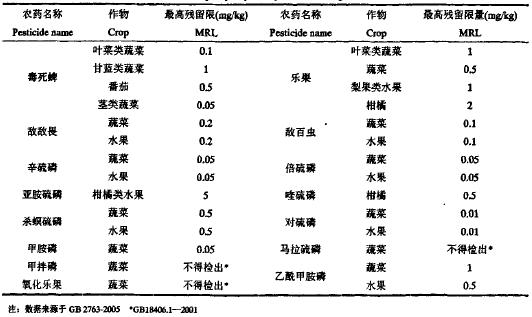The hazards of pesticide residues and their status
With the improvement of people's living standards, the quality and safety of agricultural products have become increasingly prominent. In particular, excessive pesticide residues in agricultural products directly affect the health of consumers. In current international trade, many developed countries set technical barriers to trade on the basis of the issue of pesticide residue limits, which has affected the international trade of agricultural products in China. Among them, Japan's pesticide residue standards are the most stringent. The new standard of high residue pesticides imposed in Japan reduced the amount of vegetables, fish, shrimp, and other foods imported from China in June of the same year by nearly 20% from the same period of the first half of the year. The United States has stricter standards for pesticide residues. There is still a certain gap between the standards of pesticide residues in developed and developing countries.
Pesticide residues are the general term for trace amounts of pesticides, toxic metabolites, degradants, and impurities that remain in organisms, harvests, soils, water sources, and the atmosphere. The remaining amount is called the pesticide residue and expressed in mg/kg. Pesticide residues can be divided into the following categories: insecticides, acaricides, molluscicides, fungicides, nematicides, herbicides, and plant growth regulators. Divided by source: mineral source pesticides (inorganic compounds), bio-source pesticides (natural organics, antibiotics, microorganisms) and chemical synthesis of pesticides in three major categories. Divided into chemical structures: There are dozens of types of chemical structures of organic synthetic pesticides, the main ones being: organic phosphorus (phosphine), carbamates, pyrethroids, organic chlorine compounds, etc. Among them, the most used pesticides in China are insecticides, fungicides and herbicides. The following table lists the consumption of pesticides in China.
Table China's pesticide consumption

Pesticide residue detection method
Organophosphorus pesticides are organic compounds containing CP bonds or C--O-P bonds or CSP, CNP bonds. They are mainly used as pesticides in agricultural production. The chemical formula is

Organophosphorus pesticides have the following characteristics: high efficacy, wide insecticidal spectrum; chemical structure changes are endless, the number of varieties is large. High-efficiency and low-toxicity varieties have occupied the mainstream market; chemical properties are unstable, and they are easily hydrolyzed, oxidized, thermally decomposed, and easily degraded under natural conditions or in plants and animals; easily decomposed under alkaline conditions. The following table lists the maximum residual levels of organophosphorus pesticides (MPLs) commonly used in fruits and vegetables.
Maximum organophosphorus pesticide residues in vegetables and fruits

Analytical methods for organophosphorus pesticide residues mainly include gas chromatography (GC), nitrogen phosphorus detector (NPD) or flame photometric detector (FPD), which can achieve low residual moisture analysis of most OPPs. There are also high-performance liquid chromatography, thin-layer chromatography, enzyme inhibition. Each method has its own characteristics. In different situations and different measurement requirements, different methods are selected.
Pretreatment of pesticide residues
Sample pretreatment of pesticide residues mainly includes: extraction, purification and concentration steps.
Extraction methods include: homogenization, suction filtration, ultrasonic extraction, overnight extraction, and Soxhlet extraction.
Purification methods include: liquid-liquid extraction, column chromatography, sulfonation, freezing and so on.
Concentration methods include: natural evaporation, nitrogen drying, vacuum distillation, rotary evaporation, and evaporation.
Pesticide residue analysis technology and development trend
(1) The pre-processing work is towards the direction of time saving, labor saving, low cost, solvent reduction, environmental pollution reduction, systematization, standardization, and automation.
(2) Improve the sensitivity of the detection technology to meet the lower and lower detection limit requirements in video pesticide residue analysis.
(3) Application of a simple and quick method of analysis for initial testing at the site, low cost, accurate and reliable results, and laboratory confirmation of positively reacting samples.
(4) Combine biotechnology with modern physics and chemistry analysis methods and continue to develop new analytical techniques.
(5) Modern biological pesticides will gradually replace chemical pesticides, and the focus of analysis will shift from low molecular organics to biological macromolecular pesticides.
Attach China's pesticide residue standards
(1) NY 773-2004 "Maximum Residue Limits of Acetamiprid in Fruits". This standard only stipulates the residue limits of a pesticide of the locust insecticide in fruits.
(2) NY 774-2004 "Resistance Limits of 13 Kinds of Pesticides such as Cypermethrin in Leafy Vegetables" This standard specifies the residual limits of 13 pesticides such as cypermethrin in leafy vegetables.
(3) NY 775-2004 "Residue Limits of 11 Kinds of Pesticides such as Diniconazole in Maize". This standard specifies the residue limits of 11 pesticides such as diniconazole in corn.
The polyethylene butt fusion machine is the most used with the same butt welding device, and these devices are produced and supplied from 40 to 3000 mm, and capable of welding up to a pressure of 40 atmospheres. Yuda brand plastic pipe fusion machines are based on the standard DVS2207. This company's polyethylene welding machine is designed to be unique for carrying out work on site and workshop environment. Polyethylene pipe fusion machines are manufactured using the best quality raw materials available on the market, and the company's pipe welding machines are certified by the inspectors of the water supply and power plant, and all products with warranty and after service sales are offered. These polyethylene welding machines are tested, calibrated after producing.
There are types of HDPE Plastic Pipe Butt Fusion Machines; Manual Butt Fusion Machines is the most cheapest in all series. Hydraulic butt fusion machines are used most in piping engineering. For welding quality control, it will choose data logger for hydraulic hdpe welders named data-logging pipe welding machine.Then the toppest level is CNC Welding machine for polyplastic pipes which is the most expensive and comprehensive poly pipe butt welders, CNC welding and GPS and CLOUD system is its unique feature.
Butt Fusion Machine,Fusion Machine,Fusion Equipment,Butt Fusion Welding Machine
WUXI MEIERTE MACHINERY TECHNOLOGY CO.,LTD , https://www.pipefusionweldings.com